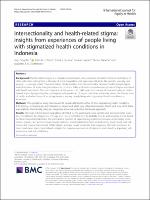| dc.description.abstract | Abstract Background Health-related stigma is a complex phenomenon, the experience of which intersects with those of other adversities arising from a diversity of social inequalities and oppressive identities like gender, sexuality, and poverty – a concept called “intersectionality”. Understanding this intersectionality between health-related stigma and other forms of social marginalization can provide a fuller and more comprehensive picture of stigma associated with health conditions. The main objective of this paper is to build upon the concept of intersectionality in health-related stigma by exploring the convergence of experiences of stigma and other adversities across the intersections of health and other forms of social oppressions among people living with stigmatized health conditions in Indonesia. Methods This qualitative study interviewed 40 people affected by either of four stigmatizing health conditions (HIV, leprosy, schizophrenia, and diabetes) in Jakarta and West Java, Indonesia between March and June 2018. Data was analyzed thematically using an integrative inductive-deductive framework approach. Results The main intersectional inequalities identified by the participants were gender and socioeconomic status ( n = 21), followed by religion ( n = 13), age ( n = 11), co-morbidity ( n = 9), disability ( n = 6), and sexuality ( n = 4). Based on these inequalities/identities, the participants reported of experiencing oppression because of prevailing social norms, systems, and policies (macro-level), exclusion and discrimination from societal actors (meso-level), and self-shame and stigma (micro-level). While religion and age posed adversities that negatively affected participants in macro and meso levels, they helped mitigate the negative experiences of stigma in micro level by improving self-acceptance and self-confidence. Conclusion This study uncovered how the experience of health-related stigma intersects with other oppressions originating from the various social inequalities in an individual’s life. The findings highlight the importance of acknowledging and understanding the multi-dimensional aspect of lives of people living with stigmatized health conditions, and warrant integrated multi-level and cross-cutting stigma reduction interventions to address the intersectional oppressions they experience. | |

